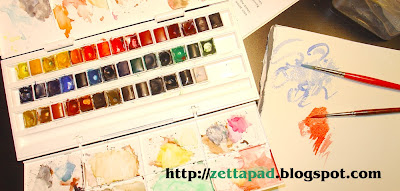What happens if you don't know how to overcome that wall? What if you've obtained the possibility to sketch, and you want to put a sketch in color? Books come in handy then. So do color wheels!
There are numerous books, instructing how to set a composition. The ways to balance it, which angles to draw it from, the direction from which you can lighten it. That's not what I'm trying to explain.
When you open a palette, like my Winsor & Newton watercolor half-pan, colors look flat to your inexperienced eye (if you're a professional, I assume you've already understood that your skills have surpassed this article looong ago). A red paints red, a yellow is just the different shades of yellow that you see in the palette; but how to mix them?
What I've found REALLY helpful, and necessary to be able to paint in a way that I can control what are the colors I'm using, is this chart below.
I think it took me equal patience and time to finish it but I never paint without taking a look at it. Surely, with time, experience teaches you what you get after mixing crimson with ultramarine instead of cadmium red with ultramarine. But the palette has many colors and it's rather impossible to remember all the different shades you can get. So, if while I'm painting, I'm trying to decide which type of green would be more suitable for my trees (ah! those greens), my chart is there to come to the rescue.
In addition, the following color wheels are also useful, but I must be honest. I had made them before the chart and I only use them for comparison between color temperatures any more.
So go ahead. Make your own chart, however detailed or not, and enjoy the splendor of color!








